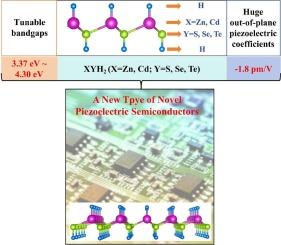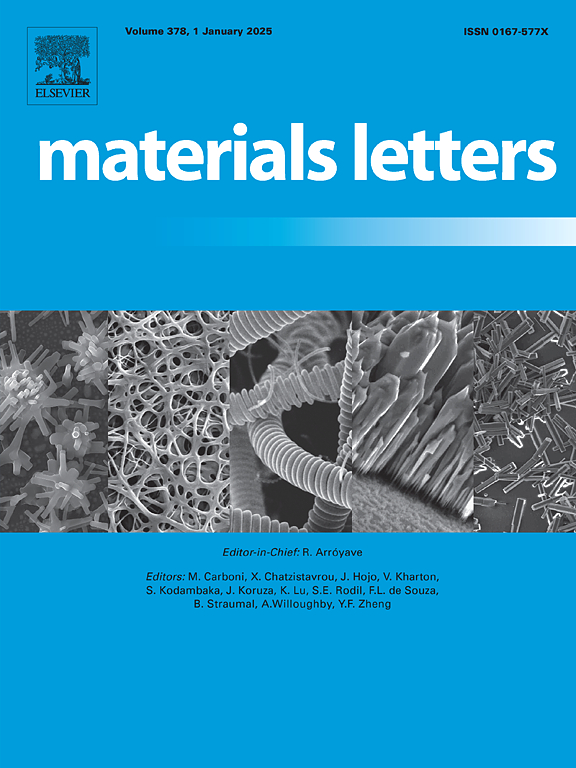Density functional theory study on the electronic structures and piezoelectric properties of hydrogenated monolayer II-VI semiconductor XYH2 (X = Zn, Cd; Y = S, Se, Te)
IF 2.7
4区 材料科学
Q3 MATERIALS SCIENCE, MULTIDISCIPLINARY
引用次数: 0
Abstract
Piezoelectric materials have been widely used in various fields such as sensing and energy catalysis. This paper primarily investigates the structural, electronic and piezoelectric properties of hydrogenated II-VI monolayer semiconductor XYH2 (X = Zn, Cd; Y = S, Se, Te) by density functional theory. Results reveal that XYH2 monolayers exhibit stable hexagonal structures and tunable bandgaps ranging from 3.27 eV to 4.30 eV. Density functional perturbation theory is employed to investigate the out-of-plane piezoelectric coefficients of XYH2 monolayers. CdSH2 exhibits a value of −1.8 pm/V of out-of-plane piezoelectric coefficients which surpasses typical piezoelectric materials such as bulk ZnS (0.076 pm/V), ZnO (0.21 pm/V), CdS (0.143 pm/V), CdSe (0.104 pm/V), BN (0.33 pm/V) and GaN (0.96 pm/V). Our results indicate that hydrogenated II-VI monolayers can be a new type of novel piezoelectric semiconductors and hold a potential application for the piezoelectric devices.

氢化单层 II-VI 半导体 XYH2(X = Zn、Cd;Y = S、Se、Te)电子结构和压电特性的密度泛函理论研究
压电材料已广泛应用于传感和能源催化等多个领域。本文主要通过密度泛函理论研究氢化 II-VI 单层半导体 XYH2(X = Zn、Cd;Y = S、Se、Te)的结构、电子和压电特性。结果表明,XYH2 单层具有稳定的六边形结构和 3.27 eV 至 4.30 eV 的可调带隙。密度泛函扰动理论用于研究 XYH2 单层的面外压电系数。CdSH2 的面外压电系数为-1.8 pm/V,超过了典型的压电材料,如块状 ZnS(0.076 pm/V)、ZnO(0.21 pm/V)、CdS(0.143 pm/V)、CdSe(0.104 pm/V)、BN(0.33 pm/V)和 GaN(0.96 pm/V)。我们的研究结果表明,氢化 II-VI 单层可以成为一种新型压电半导体,并有望应用于压电器件。
本文章由计算机程序翻译,如有差异,请以英文原文为准。
求助全文
约1分钟内获得全文
求助全文
来源期刊

Materials Letters
工程技术-材料科学:综合
CiteScore
5.60
自引率
3.30%
发文量
1948
审稿时长
50 days
期刊介绍:
Materials Letters has an open access mirror journal Materials Letters: X, sharing the same aims and scope, editorial team, submission system and rigorous peer review.
Materials Letters is dedicated to publishing novel, cutting edge reports of broad interest to the materials community. The journal provides a forum for materials scientists and engineers, physicists, and chemists to rapidly communicate on the most important topics in the field of materials.
Contributions include, but are not limited to, a variety of topics such as:
• Materials - Metals and alloys, amorphous solids, ceramics, composites, polymers, semiconductors
• Applications - Structural, opto-electronic, magnetic, medical, MEMS, sensors, smart
• Characterization - Analytical, microscopy, scanning probes, nanoscopic, optical, electrical, magnetic, acoustic, spectroscopic, diffraction
• Novel Materials - Micro and nanostructures (nanowires, nanotubes, nanoparticles), nanocomposites, thin films, superlattices, quantum dots.
• Processing - Crystal growth, thin film processing, sol-gel processing, mechanical processing, assembly, nanocrystalline processing.
• Properties - Mechanical, magnetic, optical, electrical, ferroelectric, thermal, interfacial, transport, thermodynamic
• Synthesis - Quenching, solid state, solidification, solution synthesis, vapor deposition, high pressure, explosive
 求助内容:
求助内容: 应助结果提醒方式:
应助结果提醒方式:


